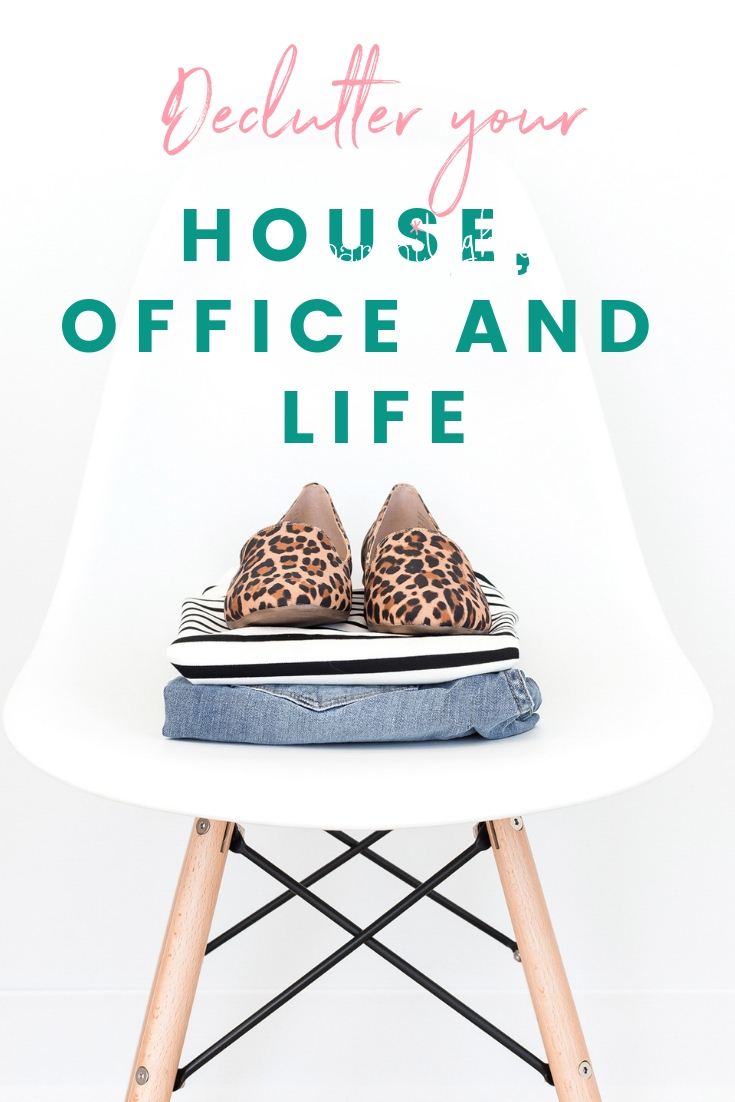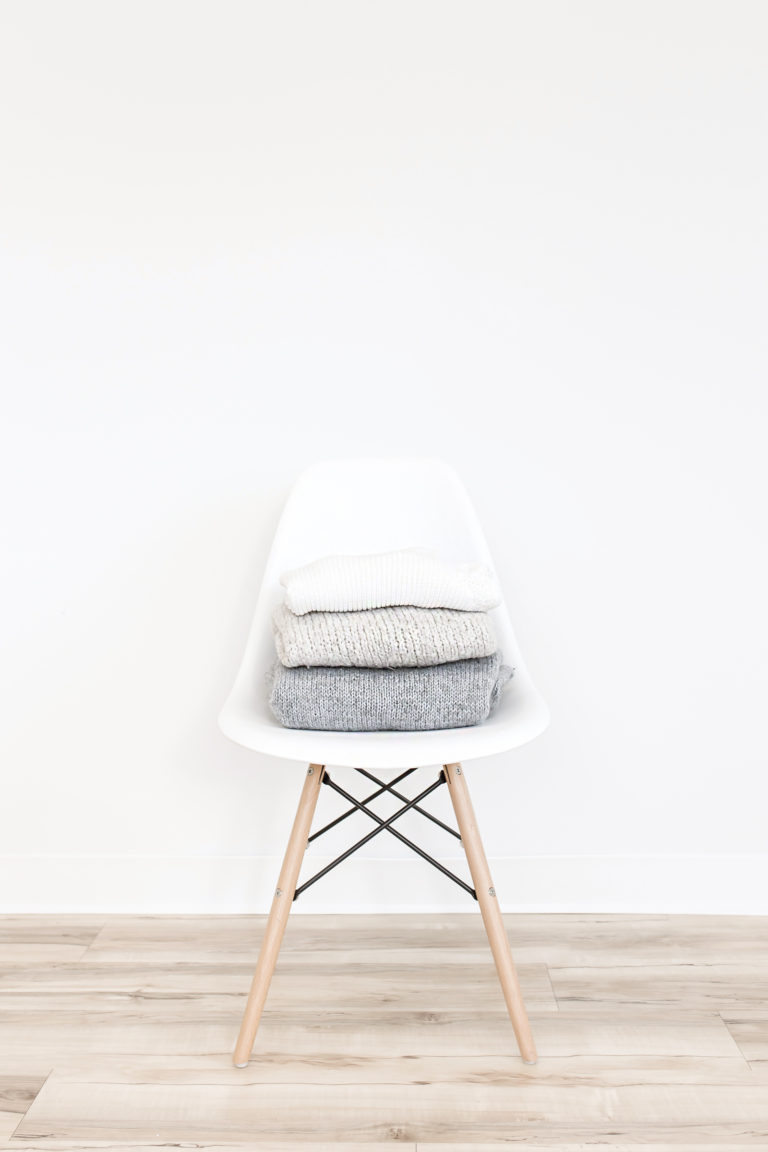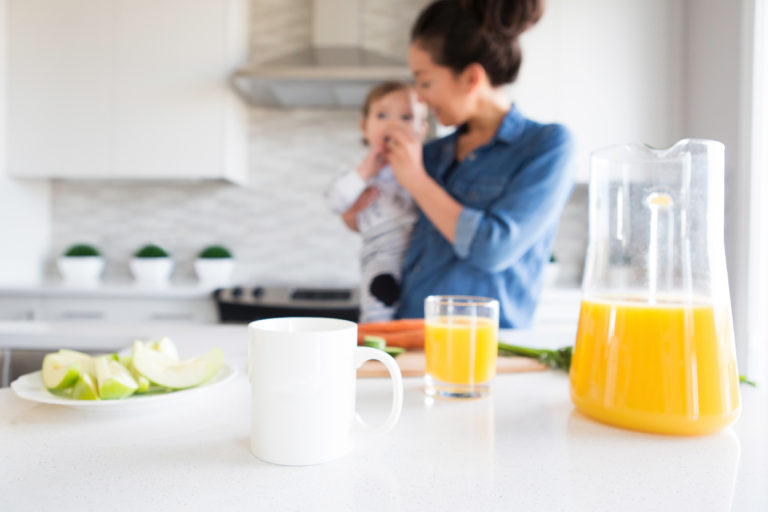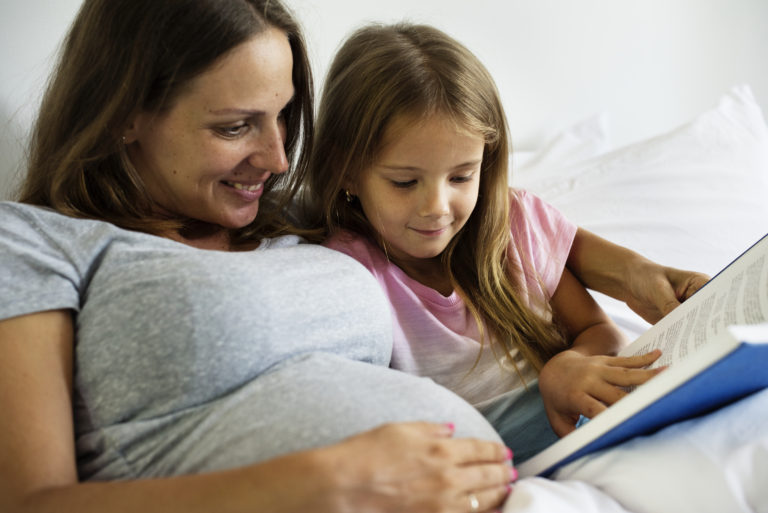Decluttering Your Home, Office and Life Step by Step
There are tons and tons of resources out there to help moms declutter. But what about working moms? I’d argue that if you work full time and are a mom, you have a whole different set of problems and priorities when it comes to decluttering. Here’s what is different and how to tackle decluttering in a way that will work for YOU.
Why Working Moms Approach Decluttering Differently
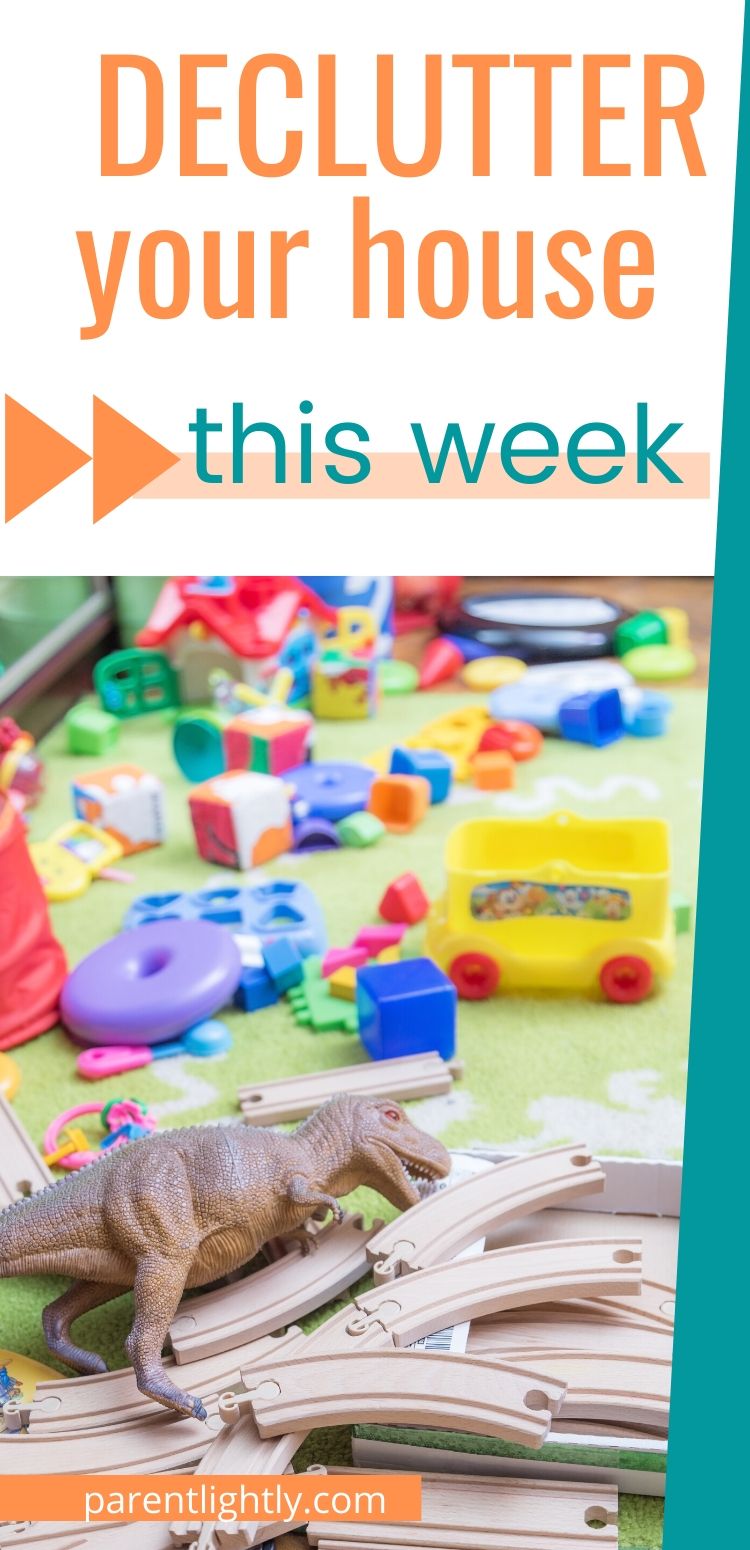
If you were a stay at home mom, you’d be at home with the kids every day to some extent. The mess would be fairly constant. You would need an everyday routine to pick up toys, run laundry and wash dishes. Instead, when you work outside of the home, things generally stay put during the day. This is both good and bad! On the negative side, if you leave the house messy in the morning, guess what it looks like when you return? (Ugh, I hate that!) On the plus side, if it’s clean when you leave it will be clean when you get back.
Because you don’t really need a full-scale daily tidying routine when it comes to toys and clothes, messes can really creep up on you over the weekend. You think you’re going to spend your weekend relaxing and having fun with your family. Suddenly it’s Sunday night, you have a mountain of laundry to deal with and the house is a mess. It’s so much more messy when you’re at home for most of the day! The kids will get out toys and art supplies. You’ll use more dishes. And on and on!
So you, as a working mom, need a strategy to leave the house tidy in the morning and to defeat the weekend mess.
Transitions are Important
For you, it’s all about the transitions. Home to kids childcare. Kids childcare to work. Work to kids to home. Kids evening routine to adult time. If the transitions don’t go well, nobody is happy. Nobody. So you have to make the transitions as easy on yourself as possible.
There is One Space You Can Control
Unlike stay at home moms, there is one space that is yours and yours alone – your work space. It might be a tiny cubicle or even just a bit of real estate on a communal desk. That’s OK. You can control that one little piece of your world and that means a lot. One space where your kids and your partner have zero say. Where you don’t have to clean up after anybody except yourself. And that’s empowering!
You May have Many Fantasy Selves
One trick to decluttering is to get rid of things that are suitable for the fantasy version of yourself instead of your actual self. I think working moms can have more than one fantasy self! There’s the hard-charging career woman who wears skirt suits and heels and is kicking ass. There’s the stay at home mom who takes her kids to baby yoga on a Tuesday at 10 am.
As working moms, I think we often feel pulled between these two paradigms without ever inhabiting either. As part of decluttering, I think it’s important for you to think about your true self and what makes sense for your life as it (even if you’re not totally satisfied with your life)! Remember, you can always buy new things if your life changes.
You Don’t Have Tons of Time
If you’re at an office during the day, you can’t declutter in short chunks of “found time” like you might have been able to if you were at home. That’s OK! It might make sense for you to declutter once a week or to set aside time on the weekends. You might not be able to do a major purge just because you’re constrained by time. That’s perfectly fine. You’ll just want to choose quick wins to give yourself some early momentum, and then just keep at it.
Decluttering for Working Moms
Since you have your own unique set of challenges, how can you tackle decluttering in a way that will bring you the most value for your life? Here’s how I would approach it, step by step.
Step 1: Your Office
This is your domain and you control it. So tackle your office first. Dispose of or shred any papers you no longer need. Go through your filing cabinets, if you have them, and clean out any old documents and notebooks.
Clean out your drawers. Throw away any dried out markers or pens. Put any unused supplies back in the supply room.
Clear your desk completely and wipe it down with Lysol wipes. Then put items back one at a time, starting with your favorite or most frequently used. Stop when the desk still feels sparse.
Make sure to clean your monitors. Pop the keys off of your keyboard with a screwdriver to clean it (this is really gross but also quite rewarding).
Once you’ve cleared clutter, set yourself up for future success. Do you need a system for dealing with papers? Maybe you sort through and file or discard papers every Friday afternoon. Do you need any personal items for the space? Maybe some cheerful art or a small plant? Think about what will make you the most energetic and effective.
Then, maintain it! Make a habit of clearing your desk every evening before you leave for at least a week. Remember, this is an awesome practice space because you are in control!
Now It’s Time to Tackle the House
At the end of a long work day, you walk into your house. The entryway is the first thing you see. The kitchen is probably the second. If those two rooms are a mess, forget it. You immediately feel stressed and muddled. The evening starts out on the wrong foot. You’re done for.
On the other hand, the entire rest of the house can be a mess but if the entryway and kitchen are tidy you’ll feel OK. You can put your stuff down, eat dinner and then deal with everything else. If you can only declutter one or two areas of the house, focus on these first.
Step 2: Routine Clutter
OK – hear me out. A ton of clutter in your house can be attributed to what I call “routine clutter.”
Case in point: until recently, my laundry system involved a ton (literally?) of clothing being somewhere in the laundry process at any given time. I would wait until someone filled up their large laundry hamper (2 loads?). Then those clothes would be washed and dried and most likely sit for days (lots) until they were folded and put away. As a result, we used a lot of clothing.
In contrast, for the last few weeks I’ve tried a new laundry system that my dad designed. It’s pretty simple. Each bedroom has a small laundry basket, the size of a load. Every time one of those baskets gets full, I run a load. If there’s no full laundry basket on a given day, I consolidate until I have enough for a load. Immediately after being washed and dried, that load is folded and put away.
This system is awesome for a lot of reasons but the funniest thing is – when we wash a load a day, the same clothes and towels get used over and over! I think we could get rid of half of our wardrobes and not notice at all. This is exactly the kind of thing you can figure out when you deal with your processes!
I could use fewer plates and cups if I washed them after each meal, but that’s impractical for me personally.
It seems like a waste of water, and realistically sometimes the dishwasher doesn’t run fast enough between breakfast and lunch on the weekends. So my method is to run the dishwasher once per day and have enough plates, cups and utensils for that. I know we have way more cups than we really need but about the right number of plates, bowls and utensils.
The point is – once you have good processes in place, you’ll know much stuff you really need vs how much is just allowing you to be lazy about your systems!
Step 3: Focus on Transitions
How many times have you spent 20 minutes looking for your keys when you really needed to rush out the door? Since I’m pretty scatterbrained I can’t even count the number of times I’ve done this! That’s why your first decluttering pass should focus on transitions. What are the key items you need every morning and evening? Make a list of the truly essential items. It might look something like this:
Morning
- Clothes
- Socks
- Shoes
- Coats, hats and gloves in winter
- Kids backpacks
- Kids lunchboxes
- Work bag
- Laptop
- Coffee mug
- Wallet
- Keys
- Cell Phone
Evening
- Cell phone charges
- Towels
- Washcloths
- Kids’ stuffed animals
- Pajamas
- Diapers
The list should contain those things that the morning or evening simply can’t proceed without. Case in point: while stuffed animals are not essential to life, I have spent many many hours searching high and low for my daughter’s “llamies” aka stuffed giraffes. She has FOUR, must sleep with all of them, and hides them in the strangest places. Point being, I could save myself a lot of heartache by organizing my space around these essential items.
Clear spaces for each essential item and make sure that the item is immediately returned to its spot after use. When we get home, shoes go in the “special spot” aka the shoe rack by the door. Keys go in the key bowl on the kitchen counter. Coats and mittens go in the coat closet. And so on. That way, we don’t have to spend valuable energy looking for these things when we have the least energy available!
Step 4: Entryway
Now it’s time to focus on the high-value areas in your home. First up: the entryway and kitchen! The entryway is the first thing you see when you walk in the door after work. It sets the mood for the whole evening. Nothing raises your blood pressure more than seeing dirty underwear or legos in your path when you come home after a long day. If you do nothing else, make sure your view from the front door is clear.
This seems silly but I treat it like trick or treating! Stand at the front door and check out the first spaces you see when you enter. Then focus on decluttering those areas really, really well. This includes the front hallway and possible a formal living room, dining room or family room (depending on your layout).
When I come in, I focus on the entryway, coat closet door and living room. For some reason, it really bugs me to see the coat closet door hanging open because it messes up the flow of the hall. So I try to close that when I leave for the day.
The entry hall is typically where my kids get dressed in the morning so it is frequently strewn with pajamas. I try to have the kids put those in the dirty clothes before we go! My husband loves to leave shoes in the living room, right where I can see them, so I try to get him to put them away frequently (or put them away myself).
Whatever your entryway looks like, try to move out any extra items and then maintain a clear space. You’ll be rewarded with a moment of calm when you get home each evening (even if the rest of the house is chaos).
Step 5: Kitchen
I think we can all agree that home life centers around the kitchen. We’re in the kitchen to prepare meals, eat them and clean up after them. The simpler this space, the more enjoyable and easy it will be to use.
Kitchens are also, somewhat mysteriously, the home of many many unused pots, utensils and other gadgets. There also seem to be a lot of kitchen items that are used very rarely (the turkey pot, or whatever it’s called. See, we use it so infrequently that I don’t even know what to call the thing.). It’s really easy to lose track of some of the stuff you have in your kitchen, and before you know it you’re overrun!
Decluttering your kitchen will be a slooow process, so make a list if you have to. Write down every cabinet and drawer, plus the pantry and refrigerator. Then start going through, one by one, and clearing them out. This might take you weeks and that is completely fine!
When you’re done clearing the cabinets and drawers, see if there’s anything currently residing on your counter that can move to a storage area. Many minimalists I know store all of their appliances and just pull them out when needed, even if that’s every day.
We haven’t gone quite to that level (the toaster, knives, coffee grinder and kettle have permanent homes on the counter) but everything else does get stored somewhere.
Step 6: Your Clothes
Decluttering your wardrobe will give you huge benefits, and it’s one of the quickest early wins. This is another area where you have total control! Start out with a first pass through all of your clothes. I use a year as my guideline: if I haven’t worn the item in a year, I donate it.
Even if I still think it’s cute, but it hasn’t fit in a year it goes into the donate pile. I’m not that hard on my clothes, but if I find an item that’s damaged I either put it into the dry cleaning bag for repair or dispose of/recycle it.
In this step, you may have to let go of the thinner version of your fantasy self. Maybe it’s been two years and you’re still trying to lose the last of your “pregnancy weight.” It may be time to face facts that this is now your actual weight.
The clothes you’re hanging on to in a smaller size probably won’t really be current even if you do eventually end up wearing that size again. I find it’s better to donate things that are too small rather than holding on to them.
After the first pass, start thinking about your clothes by category. For each category, think about what types of clothes you need and like. What do you wear day to day? What makes you feel good about yourself? Is comfort or fashion more important to you? What special occasions might you need different attire for?
Here’s an example from my work wardrobe: I almost always wear dresses, because I am lazy and this means I only have to pick out one piece. In the winter, I add a blazer or cardigan and tights. Therefore, any pants or skirts in my wardrobe can probably go (with a few exceptions that I know I wear semi-regularly). I have a few pieces that I bought when I first started my current job (9 years ago!!). They either don’t fit, are dated, or both. Those should go.
Then we get to the shoes. I give conference presentations and go to client meetings (with formal dress codes) occasionally – maybe once a month at most. As such, I like to have one pair of heels for those occasions but I don’t need more than one pair. On a regular day at the office or at a more casual client meeting, I wear flats.
This seems simple, but it’s surprisingly complicated. I have to give up on the me who loses 10 pounds and can wear those cute pencil skirts again. Then I forget the me who wears power heels frequently. I give up on the me who sports interesting but classy patterns and the me who wears pretty earrings. I’ve proven that those things just aren’t me and I’m OK with that.
The process will look a little bit different for each category! For example, my husband and I don’t do many fancy date nights, so my selection of dressy non-work clothing is very very limited and that is totally fine.
The last few weddings I’ve been to, I’ve been in, so no need to worry about finding a dress in my closet! (The next fancy occasion I attend, I’m trying Rent the Runway!) You, on the other hand, may love getting all dressed up for date nights so you might keep more fun and fancy things than I would. Do it!
Remember: keep the items that fit and make you feel amazing and fit in with your real life.
Step 7: Your Bedroom
This, friends, is your kingdom. Protect it. This is the adultiest room in my house and I plan to keep it that way. Every other room has some concession to kids – toys, shoes, books, etc etc. But the master? Nope. Keep your stuff elsewhere, kidlets.
I strongly believe that your master bedroom should serve as a sanctuary for you and your partner. We have never had a TV in our bedroom and never plan to. If you do have a TV in your room, I encourage you to reconsider. Without the TV, you can actually focus on each other when you’re in your room.
Clear the surfaces as much as possible. (This is something I’m not great at.) It’s easy to let random stuff build up on night stands, so try to clear those off. Ideally, you have bedside tables with some storage for anything you like to store near the bed.
If there is anything in the master that can be stored elsewhere, I suggest moving it. Laundry basket are my husband’s pet peeve so I’ve been trying to make an effort to keep them downstairs in the laundry room rather than upstairs in our bedroom.
Make sure you don’t store work stuff in your bedroom, either. For a short time, my husband’s desk was in our bedroom and it drove me crazy. All of the blinking lights and computer fans were so annoying. Not only will work technology psychologically distract you, the lights and noises may also keep you up at night. Find somewhere else for this stuff!
Once you’ve cleared the clutter, invest a little in making your bedroom inviting. Maybe you could use some soft, new sheets or curtains to perk up the space (and block light). Consider adding a lamp for some soft lighting or a chair for a cozy reading nook.
Invest in a grown-up piece of art (no family photos or kids drawing allowed) if that makes you happy. Make sure to keep your spouse’s tastes in mind – this particular step should be a joint effort to create a space that reflects both of you!
Profit
OK, maybe not. But after all of those steps, there will definitely be a payoff. Once you accomplish these steps you will have tackled the highest-value areas of your life. Keeping these spaces clear and minimal will bring you the maximum amount of peace and joy every day! Whether it takes you a week or a month, know that you are making progress toward your very best home, office and life.
